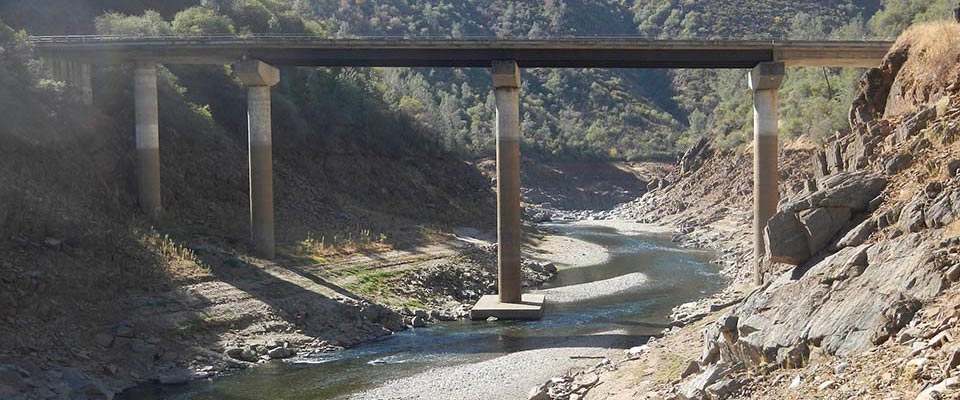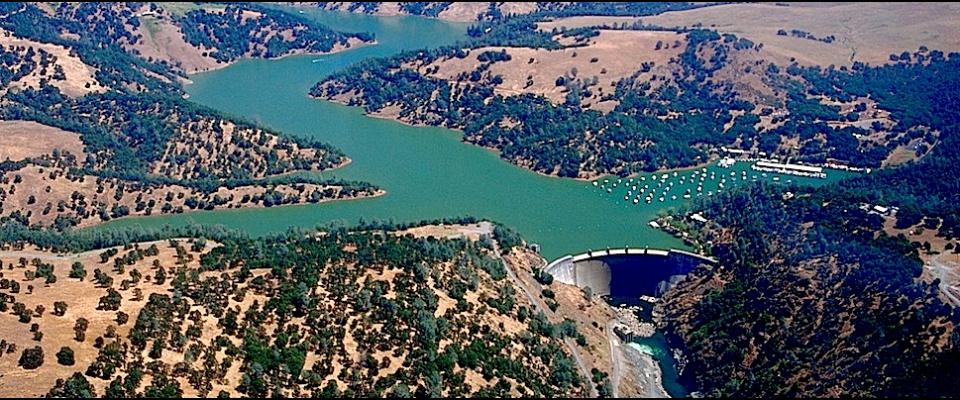The Tuolumne River has long been revered by whitewater kayakers and rafters for its pristine wilderness canyon and challenging rapids. But “The T,” as it’s known by river-runners, was once famed for something else: Salmon. Before the Hetch Hetchy and Don Pedro Dams were built on the river’s upper reaches in the last century, the Tuolumne supported up to 130,000 spawning Chinook salmon annually.
The reservoirs created by the dams were deemed necessary to accommodate California’s booming population—they still are, for that matter. Hetch Hetchy supplies San Francisco with most of its water, and also serves Alameda, Santa Clara and San Mateo Counties. Most of the water from sprawling Don Pedro Reservoir irrigates the vast croplands of the San Joaquin Valley.
But dams aren’t salmon-friendly structures. The T’s runs plummeted after the reservoirs filled, inundating prime spawning grounds and shunting water to coastal cities and San Joaquin Valley megafarms. Last year, only 434 Tuolumne salmon made it back to their natal stream to spawn.
Ultimately, the fate of the Tuolumne’s salmon could hinge on the configuration of a state water distribution strategy known as the Bay-Delta Water Quality Control Plan. Though the plan has been in the works for more than two decades, it has never been fully implemented. The State Water Resources Control Board is now accepting comments on a final version, with adoption tentatively scheduled for the spring of 2017, though few people familiar with state water politics are taking odds that it actually will be approved at that time.
Such leisurely policy timelines are hardly beneficial for California’s imperiled fisheries. In fact, says Peter Drekmeier, the policy director of the Tuolumne River Trust, it’s fairly easy to get more salmon from the Tuolumne—or from the numerous other California streams that have seen once robust salmon populations crash after dams have gone in. You just add more water.
“It’s not a coincidence that returns have been exceptionally low during the drought,” says Drekmeier, a Cal undergraduate alumnus in political science and a former mayor of Palo Alto. “Low water levels correlate with poor salmon returns. Chinook salmon typically return to spawn on two year cycles. A couple years after the extremely wet winter of 1997-1998, when the rivers ran exceptionally high, 18 thousand fish returned to the Tuolumne. And two years after the 1982-1983 winter, which marked one of the wettest years on record, 40 thousand salmon returned.”
Salmon are cold water fish, and higher rivers translate as cooler water. Spawning fish can die if temperatures get too warm—as can their eggs. Higher water also is good for “out-migrating” salmon smolts, which head out to sea in the spring.
“A big water year means more snow melt, so reservoirs have to release water to maintain safe levels,” says Drekmeier. “That creates cold, highly oxygenated and turbid downstream water. The low temperatures and high concentrations of dissolved oxygen keep the young fish healthy, and the turbidity helps them hide from predators. High water also expands the flood plain, which gives the fish additional nooks and crannies for protection. Finally, higher flows transport the smolts downstream quickly, taking them to the ocean where they find abundant cold water, relative safety, and plenty of food.”
Agricultural irrigators and urban water district managers don’t share Drekmeier’s enthusiasm for higher flows down the Tuolumne, which connects with the San Joaquin River. Such water is wasted in their eyes because it cannot be used to grow crops, irrigate golf courses, or fill glasses in restaurants. They propose other methods for bumping up salmon populations: Restoring streamside vegetation to cool downstream flows, and trucking in extra gravel to spawning grounds. (Salmon eggs must be deposited in abundant, clean gravel to assure successful hatching.)
All that’s fine as far as it goes, says Drekmeier, but such rationales attempt to finesse a basic reality: Salmon need abundant, cold, clean water to survive.
“As things stand now, the Tulolumne is better suited for black bass than salmon,” says Drekmeier. “The water is generally far too warm for salmonids. We have water hyacinths, a warm water invasive aquatic plant, clogging the lower reaches of the Tuolumne, the San Joaquin, and much of the (Sacramento-San Joaquin) Delta.”
Court decisions in the late 1980s directed the State Water Resources Control Board to issue water quality and flow standards for the Bay-Delta, revising water rights if necessary. Those decisions resulted in the 1995 Bay-Delta Water Quality Control Plan, a document establishing flow and water quality standards designed to protect the estuary’s ecosystem and imperiled fish. Ultimately, the plan could effectively determine who and what gets the water flowing from the tributaries of the San Joaquin and Sacramento Rivers (including the Tuolumne) to the Delta. But the plan was never fully implemented, and has been criticized roundly by most stakeholders in the Bay-Delta process, from salmon fishermen to farmers.
“Water quality and distribution issues all play out in the political sphere,” says Holly Doremus, a professor of environmental regulation at the Berkeley School of Law and the co-director of the school’s Center for Law, Energy & the Environment. “Revising water rights is by no means a trivial thing. Any time there is a proposed change in water allocations, there are powerful stakeholders who will fight it. So it’s difficult to determine water requirements, and even more difficult to implement them.”
Also, says Doremus, California’s water rights are enmeshed in the operation of the State Water Project and the federal Central Valley Project, the gigantic government water conveyance systems that deliver water from the Delta to south state cities and farms.
“The Brown administration is promoting the California WaterFix, which would change the intake for the projects from the south Delta where the pumps kill imperiled fish to a point to the north,” Doremus says. “But that’s facing considerable legal opposition from environmentalists because the change could increase the amount of water flowing south. That all makes the determination of water quality and control standards even more difficult.”
The State Water Quality Control Board acknowledged the essential parameters of the Tuolumne’s problem in a 2010 report that stated downstream releases of at least 60 percent of unimpaired (pre-dam) flows would be necessary to restore and protect the Tuolumne’s native fish, Drekmeier says.
But as Doremus notes, vying political constituencies exert their own pressures. In this case, the Modesto and Turlock irrigation districts, which use much of the Tuolumne’s water, decreed that a 60 percent figure was way too high. So in 2012, when the board considered a revised Bay-Delta Water Quality Control Plan, the proposed figure for the Tuolumne was 35 percent of unimpaired flows from February through June.
“That’s the critical time for salmon,” Drekmeier says. “The eggs are hatching in late winter, and the young fish are trying to get downstream in late spring and early summer. That’s when they need the water, and 35 percent simply isn’t enough.”
Nor were water purveyors pleased by the figure; they felt 35 percent was still too much. So the plan went back to the drawing boards, and in September a revised version was released, one calling for 40 percent of unimpaired flows. Drekmeier would be utterly opposed to the new goals, save that the revised plan includes measures (such as streamside re-vegetation) that, if successful, would reduce releases down the Tuolumne to 30 percent, but would increase flows to 50 percent if fish goals were not met.
That’s still below the 60 percent figure fisheries scientists generally cite as necessary, but Drekmeier thinks it might be sufficient to give the Tuolumne’s salmon a fighting chance.
“The science says 60 percent,” says Drekmeier, “and while this plan doesn’t get us there, it’s far better than earlier proposals. We understand that we’re going to have to work with all parties to bring the salmon back.”
Bill Kier, a fisheries consultant who has worked on state salmon and steelhead issues since the 1950s, says that salmon won’t thrive on the Tuolumne until enough water is released so the channel level rises to reach streamside trees during critical times of the year.
“These salmon evolved with these seasonal little high water channels,” says Kier, who attended Cal. “A tremendous amount of food comes off the trees when the water reaches up to them, food that’s critical for the survival of juvenile salmon. So flows have to be sufficient to reach the treeline. If you reshape the river and replant trees to accommodate a skinnier channel, even if all other things are equal, you’re going to have 25 or 30 years before the trees reach sufficient size to provide sufficient food to young fish. You could lose the entire run during that interim.”
Drekmeier knows that competition for water is fierce in the state and he doesn’t want to dump on any of the constituents, including farmers, vying for a limited resource that gets more precious every drought-plagued year.
“I don’t count myself as one of those people who condemn all agriculture in the Central Valley,” Drekmeier says. “I’ve heard it said that it’s not polite to criticize farmers when you have a full mouth, and to a degree that’s true. But our water is a public trust resource. It belongs to all the people, not just a handful of farmers. And when large corporate farms are making vast profits on public water for export crops such as almonds, that amounts to an unfair subsidy. Our fisheries need and deserve their share. Wild salmon is a food too, one that’s widely enjoyed and is in high demand. Our salmon also support a lot of people economically, from commercial fishermen to charter boat operators, seafood processors and restaurant workers.”




















